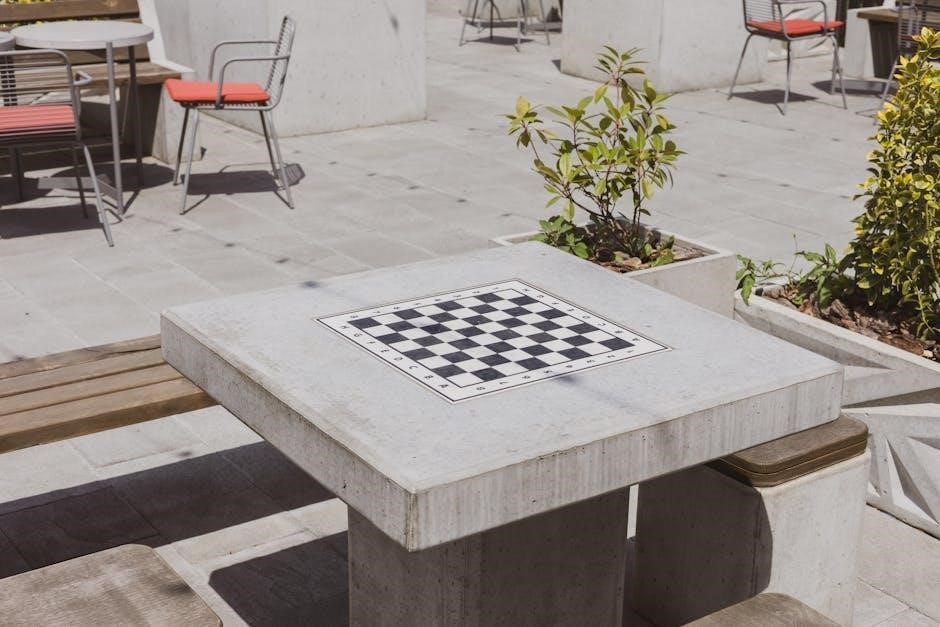Brian Eno and Peter Schmidt created Oblique Strategies in the 1970s as a deck of cards with aphorisms to spark creativity and overcome artistic blocks. The PDF version makes these strategies accessible, offering a timeless tool for breaking creative stalemates.
1.1 Background and Historical Context
Brian Eno and Peter Schmidt created Oblique Strategies in the mid-1970s as a tool to inspire creativity and challenge artistic stagnation. First published in 1975, the deck evolved through editions in 1978 and 1979, reflecting Eno’s experimental approach to music and art. Initially designed for musicians, the strategies soon gained relevance across various creative fields. The PDF version of Oblique Strategies emerged as a digital adaptation, preserving the original intent while expanding accessibility. These aphorisms and dilemmas were crafted to disrupt conventional thinking, encouraging lateral problem-solving. The deck’s enduring popularity highlights its universal appeal, bridging the gap between physical and digital formats. This innovative concept remains a cornerstone of Eno’s legacy in fostering creativity.
1.2 The Collaboration with Peter Schmidt
Brian Eno’s collaboration with artist Peter Schmidt began in the early 1970s, leading to the creation of Oblique Strategies. Schmidt’s visual and conceptual contributions complemented Eno’s musical and philosophical ideas, forming a unique partnership. Their joint effort resulted in a deck of cards designed to challenge creative norms. The PDF version of Oblique Strategies captures the essence of their collaboration, offering insights into their shared vision of fostering innovation. Schmidt’s influence on the project ensured a balanced blend of artistic and theoretical perspectives, making the deck a timeless resource for creative problem-solving. This collaboration remains a testament to the power of interdisciplinary teamwork in generating groundbreaking ideas.
1.3 The Evolution of the Deck: 1975, 1978, and 1979 Editions

The Oblique Strategies deck evolved significantly across its 1975, 1978, and 1979 editions. The initial 1975 edition introduced the core concept of using aphorisms to stimulate creativity. By 1978, Eno and Schmidt expanded the deck, refining the strategies and adding new cards to enhance its versatility. The 1979 edition further polished the collection, solidifying its reputation as a tool for artistic and musical innovation. Each iteration reflected Eno’s ongoing exploration of creativity and problem-solving, ensuring the deck remained a dynamic and adaptable resource. The PDF version captures this evolution, offering a comprehensive view of the strategies that have inspired countless artists and musicians over the years.
The Structure and Content of Oblique Strategies
Oblique Strategies consists of over 100 cards, each containing a phrase or dilemma designed to provoke creative thinking and challenge conventional approaches. The PDF version neatly organizes these strategies, ensuring accessibility for artists and musicians seeking inspiration.
2.1 The Concept of Aphorisms and Dilemmas
Brian Eno’s Oblique Strategies employs aphorisms and dilemmas to stimulate lateral thinking. Each card presents a concise, often cryptic statement, such as “Abandon normal instruments” or “A line has two sides.” These phrases are designed to disrupt routine creative processes, encouraging artists to explore unconventional solutions. The PDF version preserves this concept, offering a digital format that maintains the original intent. By presenting paradoxical or ambiguous prompts, Eno and Schmidt’s work challenges users to rethink their approaches, fostering innovation across various artistic disciplines. This method has proven enduringly effective, making Oblique Strategies a timeless creative resource.
2.2 Key Principles: Abandoning Normal Processes and Embracing Ambiguity
The core of Oblique Strategies lies in its principles of abandoning conventional methods and embracing ambiguity. By encouraging artists to step away from familiar techniques, Eno’s system prompts fresh perspectives, often through unexpected juxtapositions. The PDF version maintains this essence, offering digital access to these transformative ideas. Ambiguity is central, as the cards’ open-ended nature allows for multiple interpretations, fostering a mindset that values exploration over certainty. This approach not only combats creative stagnation but also enriches the artistic process, making Oblique Strategies a powerful tool for innovation across various fields. Its enduring relevance highlights the importance of flexibility and adaptability in creative endeavors.
2.3 Examples of Specific Strategy Cards

The Oblique Strategies deck includes over 100 cards, each with a unique prompt designed to provoke creative thinking. Examples like “Abandon normal instruments” and “Accept advice” challenge artists to rethink their approaches. Another card, “A line has two sides,” encourages considering multiple perspectives. These aphorisms, such as “Allow an easement (an easement is the abandonment of a stricture),” push creators to embrace flexibility. The PDF version preserves these strategies, offering digital access to Eno’s innovative ideas. Each card serves as a catalyst for overcoming creative blocks, making Oblique Strategies a timeless resource for artists and problem-solvers alike. The examples embody the principles of abandoning norms and embracing ambiguity, central to Eno’s philosophy.

The Impact of Oblique Strategies on Creativity
Brian Eno’s Oblique Strategies stimulate innovation by encouraging lateral thinking and breaking creative blocks. Their versatility applies to music, art, and problem-solving, fostering fresh perspectives universally.
3.1 Overcoming Creative Blocks and Sparking Innovation
Brian Eno’s Oblique Strategies are renowned for their ability to disrupt stagnant creative processes. By presenting ambiguous or paradoxical prompts, the cards encourage artists to think beyond conventional approaches. For instance, strategies like “Abandon normal instruments” or “Accept advice” challenge creators to step out of their comfort zones. This randomness sparks fresh perspectives, helping to bypass mental barriers. The deck’s versatility ensures its applicability across various disciplines, from music to visual arts. Over time, the strategies have proven invaluable for artists seeking to reignite their creative spark and explore uncharted territories. Their enduring relevance lies in their ability to foster innovation and push boundaries in diverse creative endeavors.

3.2 Applications Beyond Music: Art, Problem-Solving, and More
Brian Eno’s Oblique Strategies extend far beyond their origins in music, offering a versatile toolkit for diverse creative fields. Visual artists, writers, and even problem-solvers have embraced the deck’s prompts to stimulate innovation. Strategies like “Ask people to work against their better judgement” encourage unconventional thinking, making them ideal for artistic collaborations. Beyond art, the cards are used in design, education, and business to tackle complex challenges. Their ability to provoke lateral thinking has made them a go-to resource for anyone seeking to break free from traditional frameworks. This broad applicability underscores the timeless relevance of Eno’s approach to creativity and problem-solving.
3.3 The Role of Randomness and Lateral Thinking
Brian Eno’s Oblique Strategies harness the power of randomness to stimulate lateral thinking, encouraging users to step outside conventional approaches. By drawing a random card, individuals are presented with unexpected prompts that disrupt routine thought patterns. This method fosters creativity by introducing unforeseen perspectives, allowing artists and problem-solvers to bypass logical constraints. The strategies often challenge users to abandon normal processes and embrace ambiguity, leading to innovative solutions. For example, prompts like “Ask people to work against their better judgement” or “Abandon normal instruments” push creators to explore uncharted territory. This emphasis on randomness and lateral thinking makes the deck a powerful tool for overcoming creative and intellectual obstacles across various disciplines.

The PDF Version of Oblique Strategies
The PDF version of Brian Eno and Peter Schmidt’s Oblique Strategies offers a digital adaptation of the original deck, providing over 150 creative prompts to spark innovation and overcome artistic stalemates.
4.1 Accessing the PDF: Sources and Availability
The Oblique Strategies PDF is widely available online, offering easy access to Brian Eno and Peter Schmidt’s creative prompts. It can be downloaded from various sources, including stretta.com and Monoskop, ensuring accessibility for artists and creators worldwide. Additionally, community-driven platforms and fan-created websites host the PDF, making it simple to find and use. The digital format allows users to easily share and integrate these strategies into their creative workflows, providing a convenient alternative to the physical deck. Its widespread availability has made the PDF a popular resource for overcoming creative blocks and fostering innovation across diverse fields.

4.2 The Format and Layout of the PDF
The Oblique Strategies PDF features a clean, minimalist design, mirroring the original card deck’s simplicity. Each page typically contains a single strategy, presented in a clear, readable font. The layout ensures that users can easily focus on one idea at a time, enhancing the tool’s effectiveness. Some versions include multiple strategies per page, while others maintain the original one-card-per-page format. The PDF’s structure is optimized for both digital viewing and printing, allowing users to integrate it seamlessly into their creative processes. This straightforward design preserves the essence of Eno and Schmidt’s original concept, making it accessible and user-friendly for modern creators.

4.3 Comparing the Digital Version to the Physical Deck
The digital PDF version of Oblique Strategies offers convenience and accessibility compared to the physical deck. Users can easily navigate and print the strategies, while the digital format allows for instant access across devices. However, the tactile experience of shuffling and drawing cards is lost in the digital version. The physical deck’s randomness and sensory interaction enhance the creative process, making each draw feel unique. Despite this, the PDF remains a practical alternative, ensuring that Eno’s strategies reach a broader audience and integrate seamlessly into modern workflows. Both formats retain the essence of the original concept, fostering creativity and innovation in various artistic fields.
Practical Uses of Oblique Strategies
The PDF version of Oblique Strategies is a versatile tool for musicians, artists, and problem-solvers, offering accessible prompts to break creative blocks and inspire innovation across various disciplines.
5.1 For Musicians: Breaking Out of Stale Creative Routines
Musicians often face creative stagnation, and Brian Eno’s Oblique Strategies offers a solution. The PDF version provides accessibility to these innovative prompts, encouraging artists to abandon conventional methods. Phrases like “Abandon normal instruments” or “Accept advice” push musicians to explore unconventional sounds and techniques. By embracing randomness and lateral thinking, the strategies spark fresh approaches, helping to overcome repetitive patterns. The deck’s emphasis on breaking creative blocks has made it a timeless tool for musicians seeking to reignite their inspiration and innovate. Its influence is evident in its widespread use across various genres, proving its enduring relevance in modern music production.
5.2 For Artists: Encouraging Experimental Approaches
Brian Eno’s Oblique Strategies has become a cornerstone for visual artists seeking to push boundaries. The PDF version offers a convenient way to access these provocative prompts, inspiring artists to challenge their usual practices. Statements like “A line has two sides” or “Allow an easement” encourage exploring new perspectives and techniques. By embracing ambiguity and unpredictability, artists can break free from creative constraints, fostering innovative and unexpected outcomes. This approach aligns with Eno’s philosophy of encouraging lateral thinking, making the deck a valuable resource for those looking to experiment and broaden their artistic horizons. Its influence extends beyond music, enriching various forms of creative expression.
5.3 For General Problem-Solving: Thinking Outside the Box
Brian Eno’s Oblique Strategies offers a unique approach to general problem-solving by encouraging lateral thinking. The PDF version provides easy access to these innovative prompts, which can be applied to various challenges. Phrases like “Ask people to work against their better judgement” or “Abandon normal instruments” inspire individuals to break free from conventional thinking. By embracing randomness and ambiguity, these strategies help bypass traditional problem-solving methods, fostering creative and unconventional solutions. Eno’s approach, originally designed for artistic contexts, has proven invaluable for anyone seeking to think outside the box and tackle complex issues with fresh perspectives. The PDF format ensures that these timeless strategies remain accessible and applicable across diverse fields.

The Cultural Significance of Oblique Strategies
Brian Eno’s Oblique Strategies has deeply influenced modern artistic practices, inspiring creativity across music, art, and problem-solving. Its legacy lies in fostering innovation and lateral thinking, reflecting Eno’s unique philosophical approach;
6.1 Influence on Modern Artistic Practices
Brian Eno’s Oblique Strategies has profoundly shaped modern artistic practices, offering a unique framework for overcoming creative barriers. Musicians, visual artists, and even technologists have embraced the deck’s aphorisms to foster innovation. The PDF version has democratized access, allowing global creators to apply these strategies. By encouraging lateral thinking and experimentation, Eno’s approach has inspired new methodologies across disciplines. Its influence is evident in collaborative projects, experimental art, and problem-solving techniques. The strategies’ adaptability ensures their relevance in evolving creative landscapes, making them a timeless tool for artists seeking fresh perspectives.
6.2 Legacy in Creative Industries
Brian Eno’s Oblique Strategies has left an indelible mark on creative industries, inspiring a generation of artists, musicians, and thinkers. The deck’s emphasis on breaking conventions has influenced seminal works in music, visual arts, and beyond. Its principles are reflected in collaborative projects, experimental art, and innovative problem-solving techniques. The PDF version has further cemented its legacy, ensuring accessibility and widespread adoption. By fostering a culture of lateral thinking and creative risk-taking, Eno’s strategies continue to shape contemporary practices. Their enduring relevance underscores the timeless value of Eno’s philosophy, making Oblique Strategies a cornerstone of modern creativity.

6.3 Eno’s Unique Personality and Philosophical Approach
Brian Eno’s unique personality and philosophical approach are deeply embedded in Oblique Strategies. His curiosity, creativity, and willingness to challenge norms define the essence of the deck. Eno’s belief in the power of lateral thinking and embracing ambiguity has inspired countless artists and thinkers. His philosophy emphasizes creative freedom, encouraging individuals to step beyond conventional boundaries. The strategies reflect his interdisciplinary mindset, blending music, art, and technology seamlessly. Eno’s ability to simplify complex ideas into actionable prompts has made Oblique Strategies a timeless resource. His influence extends beyond the deck, shaping modern artistic practices and fostering innovation across industries. The PDF version ensures his vision remains accessible, continuing to inspire future generations.
The Digital Age and Oblique Strategies
The digital age has transformed Oblique Strategies into web-based tools and apps, enabling global access and fostering community-driven creativity through shared strategies and digital innovations.
7.1 Web-Based Implementations and Apps
The digital era has enabled the creation of web-based tools and apps inspired by Oblique Strategies. These platforms offer interactive experiences, allowing users to generate random strategies or explore the entire deck digitally. Some implementations include features like customizable lists, shared strategies, and community-driven content. For instance, websites like obliquestrategies.ca provide a dynamic interface for accessing the strategies, while mobile apps offer portability and convenience. These tools not only preserve the original concept but also expand its reach, making it accessible to a global audience. The integration of technology enhances the user experience, fostering creativity and collaboration in new and innovative ways.
7.2 Community-Driven Strategies and Shared Experiences
The rise of digital platforms has fostered a sense of community around Oblique Strategies. Users worldwide share their experiences and strategies, creating a collaborative environment that expands the original concept. Online forums and social media groups dedicated to the deck allow individuals to discuss how specific strategies have influenced their work. Additionally, some platforms enable users to contribute their own strategies, further enriching the collective pool of creative prompts. This shared approach not only enhances the tool’s versatility but also highlights its universal appeal across various artistic disciplines. The community-driven aspect ensures that Oblique Strategies remain a dynamic and evolving resource for creativity.
7.3 The Role of Technology in Enhancing the Original Concept
Technology has significantly enhanced the accessibility and functionality of Oblique Strategies. Digital versions, including web-based apps and mobile applications, allow users to draw strategies with ease, making the tool more portable and convenient. The PDF format has also played a crucial role in disseminating the strategies globally, ensuring that Eno’s creative prompts reach a broader audience. Additionally, interactive platforms now enable users to share their own strategies, fostering a sense of community and collaboration. These technological advancements not only preserve the original intent of the deck but also expand its potential, making it a versatile tool for modern creators. The integration of technology has breathed new life into this timeless concept.
Oblique Strategies remains a timeless creative tool, inspiring innovation across art, music, and problem-solving. Its digital formats ensure accessibility, while its philosophical core continues to influence future adaptations.
8.1 The Timeless Appeal of Oblique Strategies
Oblique Strategies continues to captivate creators due to its universal relevance. The PDF version ensures accessibility, allowing artists, musicians, and thinkers to embrace Eno’s philosophy of breaking conventions and fostering innovation. Its essence lies in simplicity, offering cryptic yet profound prompts that transcend time and disciplines. The strategies’ ability to spark lateral thinking and challenge norms has cemented their place as a vital tool in creative processes. As technology evolves, the digital format bridges the gap between past and future, ensuring Eno’s insights remain a cornerstone for generations seeking inspiration and overcoming creative barriers.
8.2 The Potential for New Iterations and Adaptations
The Oblique Strategies PDF opens doors for fresh interpretations, allowing new generations to reinterpret Eno’s principles. Digital platforms and apps can enhance the original concept, offering interactive features that expand its reach. Collaborative efforts, such as community-driven strategies, encourage diverse perspectives, ensuring the deck remains dynamic. The modularity of the PDF format facilitates easy updates, enabling the integration of new ideas while preserving the core philosophy. As technology advances, so too does the potential for Oblique Strategies to evolve, maintaining its relevance and inspiring innovation across various creative fields, from music to visual arts and beyond.
8.3 The Enduring Legacy of Brian Eno’s Creative Philosophy
Brian Eno’s Oblique Strategies has left an indelible mark on creativity, transcending music and art. The PDF version ensures accessibility, allowing Eno’s principles to influence new generations. His emphasis on lateral thinking and embracing ambiguity continues to inspire problem-solving and innovation. As a cultural icon, Eno’s philosophy fosters a mindset that values unpredictability and creative freedom. The deck’s evolution into digital formats highlights its timeless relevance, making it a cornerstone of modern artistic practices. Eno’s legacy extends beyond his music, shaping how creators approach challenges and sparking new ideas globally. His work remains a testament to the power of innovative thinking and the enduring impact of his unique vision.


